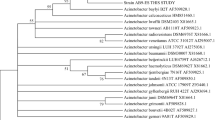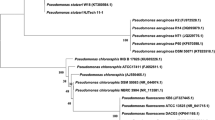Abstract
Acinetobacter species are identified as producing surface-active and emulsifying molecules known as bioemulsifiers. Production, characterization and stability of bioemulsifiers produced by Acinetobacter bouvetii UAM25 were studied. A. bouvetii UAM25 grew in three different carbon and energy sources: ethanol, a glycerol–hexadecane mixture and waste cooking oil in an airlift bioreactor, showing that bioemulsifier production was growth associated. The three purified bioemulsifiers were lipo-heteropolysaccharides of high molecular weight (4866 ± 533 and 462 ± 101 kDa). The best carbon source and energy for bioemulsifier production was wasted cooking oil, with a highest emulsifying capacity (76.2 ± 3.5 EU mg−1) as compared with ethanol (46.6 ± 7.1 EU mg−1) and the glycerol–hexadecane mixture (49.5 ± 4.2 EU mg−1). The three bioemulsifiers in our study displayed similar macromolecular structures, regardless of the nature (hydrophobic or hydrophilic) of the carbon and energy source. Bioemulsifiers did not decrease surface tension, but the emulsifying capacity of all of them was retained under extreme variation in salinity (0–50 g NaCl L−1), pH (3–10) and temperature (25–121 °C), indicative of remarkable stability. These findings contribute to understanding of the relationship between: production, physical properties, chemical composition and stability of bioemulsifiers for their potential applications in biotechnology, such as bioremediation of hydrocarbon-contaminated soil and water.



Similar content being viewed by others
References
Manivasagan P, Sivasankar P, Venkatesan J, Sivakumar K, Kim SK (2014) Optimization, production and characterization of glycolipid biosurfactant from the marine actinobacterium, Streptomyces sp. MAB36. Bioprocess Biosyst Eng 37:783–797. https://doi.org/10.1007/s00449-013-1048-6
Zambry NS, Ayoib A, Noh NAM, Yahya ARM (2017) Production and partial characterization of biosurfactant produced by Streptomyces sp. R1. Bioprocess Biosyst Eng 40:1007–1016. https://doi.org/10.1007/s00449-017-1764-4
Zhao Y, Chen L, Tian Z, Sun Y, Liu J, Huang L (2016) Characterization and application of a novel bioemulsifier in crude oil degradation by Acinetobacter beijerinckii ZRS. J Basic Microbiol 56:184–195. https://doi.org/10.1002/jobm.201500487
Uzoigwe C, Burgess JG, Ennis CJ, Rahman PKSM. (2015) Bioemulsifiers are not biosurfactants and require different screening approaches. Front Microbiol 6:1–6. https://doi.org/10.3389/fmicb.2015.00245
Rosenberg E, Perry A, Gibson DT, Gutnick DL (1979) Emulsifier of Arthrobacter RAG-1: specificity of hydrocarbon substrate. Appl Environ Microbiol 37:409–413. https://doi.org/10.1016/0014-5793(79)81320-4
Amani H, Kariminezhad H (2016) Study on emulsification of crude oil in water using emulsan biosurfactant for pipeline transportation. Pet Sci Technol 34:216–222. https://doi.org/10.1080/10916466.2015.1118500
Jung J, Park W (2015) Acinetobacter species as model microorganisms in environmental microbiology: current state and perspectives. Appl Microbiol Biotechnol 99:2533–2548. https://doi.org/10.1007/s00253-015-6439-y
Su WT, Chen WJ, Lin YF (2009) Optimizing emulsan production of A. venetianus RAG-1 using response surface methodology. Appl Microbiol Biotechnol 84:271–279. https://doi.org/10.1007/s00253-009-1957-0
Toren A, Navon-Venezia S, Ron EZ, Rosenberg E (2001) Emulsifying Activities of Purified Alasan Proteins from Acinetobacter radioresistens KA53. Appl Environ Microbiol 67:1102–1106. https://doi.org/10.1128/AEM.67.3.1102-1106.2001
Pirog TP, Konon AD, Shevchuk TA, Bilets IV (2012) Intensification of biosurfactant synthesis by Acinetobacter calcoaceticus IMV B-7241 on a hexadecane-glycerol mixture. Microbiology 81:565–572. https://doi.org/10.1134/S0026261712050128
Affandi IE, Suratman NH, Abdullah S, Ahmad WA, Zakaria ZA (2014) Degradation of oil and grease from high-strength industrial effluents using locally isolated aerobic biosurfactant-producing bacteria. Int Biodeterior Biodegrad 95:33–40. https://doi.org/10.1016/j.ibiod.2014.04.009
Amodu OS, Ojumu TV, Ntwampe SKO (2016) Kinetic modelling of cell growth, substrate utilization, and biosurfactant production from solid agrowaste (Beta vulgaris) by Bacillus licheniformis STK 01. 94:2268–2275 https://doi.org/10.1002/cjce.22631
de Jesus SS, Neto JM, Maciel Filho R (2017) Hydrodynamics and mass transfer in bubble column, conventional airlift, stirred airlift and stirred tank bioreactors, using viscous fluid: a comparative study. Biochem Eng J 118:70–81. https://doi.org/10.1016/j.bej.2016.11.019
Denis B, Pérez OA, Lizardi-Jiménez MA, Dutta A (2016) Numerical evaluation of direct interfacial uptake by a microbial consortium in an airlift bioreactor. Int Biodeterior Biodegrad 119:542–551. https://doi.org/10.1016/j.ibiod.2016.08.012
Tzintzun-Camacho O, Loera O, Ramírez-Saad HC, Gutiérrez-Rojas M (2012) Comparison of mechanisms of hexadecane uptake among pure and mixed cultures derived from a bacterial consortium. Int Biodeterior Biodegrad 70:1–7. https://doi.org/10.1016/j.ibiod.2012.01.009
Lizardi-Jiménez MA, Leal-Bautista RM, Ordaz A, Reyna-Velarde R (2014) Airlift bioreactors for hydrocarbon water pollution remediation in a tourism development pole. Desalin Water Treat. https://doi.org/10.1080/19443994.2013.876670
Kaur T, Ghosh M (2015) Acinetobacter haemolyticus MG606 produces a novel, phosphate binding exobiopolymer. Carbohydr Polym 132:72–79. https://doi.org/10.1016/j.carbpol.2015.06.002
Pirog TP, Korzh IV, Shevchuk TA (2009) Effect of cultivation conditions on the physicochemical properties of exopolysaccharide ethapolan. Prikl Biokhim Mikrobiol 45:58–63. https://doi.org/10.1134/S0003683809010098
Vázquez-Vázquez JL, Ortega-de la Rosa ND, Huerta-Ochoa S, Gimeno M, Gutiérrez-Rojas M (2017) Novel exopolysaccharide produced by Acinetobacter bouvetii UAM25: production, characterization and PHAs bioemulsifying capability. Rev Mex Ing Química 16:721–733
Zwietering MH, Jongenburger I, Rombouts FM, Van’t Riet K (1990) Modeling of the bacterial growth curve. Appl Environ Microbiol 6:1875–1881
DuBois M, Gilles K, Hamilton JK, Rebers P, Smith F (1956) Colorimetric method for determination of sugars and related substances. Anal Chem 28:350–356. https://doi.org/10.1021/ac60111a017
Bradford MM (1976) A rapid and sensitive method for the quantitation of microgram quantities of protein utilizing the principle of protein-dye binding. Anal Biochem 72:248–254. https://doi.org/10.1016/0003-2697(76)90527-3
Sivapathasekaran C, Sen R (2017) Origin, properties, production and purification of microbial surfactants as molecules with immense commercial potential. Tenside Surf Det 54:92–107
Leth IK, McDonald KA (2017) Growth kinetics and scale-up of Agrobacterium tumefaciens. Appl Microbiol Biotechnol 101:4895–4903. https://doi.org/10.1007/s00253-017-8241-5
Henkel M, Schmidberger A, Vogelbacher M, Kühnert C, Beuker J, Bernard T, Schwartz T, Syldatk C, Hausmann R (2014) Kinetic modeling of rhamnolipid production by Pseudomonas aeruginosa PAO1 including cell density-dependent regulation. Appl Microbiol Biotechnol 98:7013–7025. https://doi.org/10.1007/s00253-014-5750-3
Kannisto M, Efimova E, Karp M, Santala V (2017) Growth and wax ester production of an Acinetobacter baylyi ADP1 mutant deficient in exopolysaccharide capsule synthesis. J Ind Microbiol Biotechnol 44:99–105. https://doi.org/10.1007/s10295-016-1872-1
Bao M, Pi Y, Wang L, Sun P, Li Y, Cao L (2014) Lipopeptide biosurfactant production bacteria Acinetobacter sp. D3-2 and its biodegradation of crude oil. Environ Sci Process Impacts 16:897. https://doi.org/10.1039/c3em00600j
Uttatree S, Winayanuwattikun P, Charoenpanich J (2010) Isolation and characterization of a novel thermophilic-organic solvent stable lipase from Acinetobacter baylyi. Appl Biochem Biotechnol 162:1362–1376. https://doi.org/10.1007/s12010-010-8928-x
Kar T, Destain J, Thonart P, Delvigne F (2012) Physical and physiological impacts of different foam control strategies during a process involving hydrophobic substrate for the lipase production by Yarrowia lipolytica. Bioprocess Biosyst Eng 35:483–492. https://doi.org/10.1007/s00449-011-0614-z
Zheng X, Wu N, Fan Y (2012) Characterization of a novel lipase and its specific foldase from Acinetobacter sp. XMZ-26. Process Biochem 47:643–650. https://doi.org/10.1016/j.procbio.2012.01.005
Moradi S, Razavi SH, Mousavi SM, Gharibzahedi SMT (2015) Optimization and partial purification of a high-activity lipase synthesized by a newly isolated Acinetobacter from offshore waters of the Caspian Sea under solid-state fermentation. RSC Adv 5:12052–12061. https://doi.org/10.1039/C4RA10485D
Dong H, Xia W, Dong H, She Y, Zhu P, Liang K, Hickey WJ, Fields MW (2016) Rhamnolipids produced by indigenous Acinetobacter junii from petroleum reservoir and its potential. Enhanced Oil Recovery 7:1–13. https://doi.org/10.3389/fmicb.2016.01710
Wu J, Zhang J, Wang P, Zhu L, Gao M, Zheng Z, Zhan X (2017) Production of rhamnolipids by semi-solid-state fermentation with Pseudomonas aeruginosa RG18 for heavy metal desorption. Bioprocess Biosyst Eng 40:1–9. https://doi.org/10.1007/s00449-017-1817-8
Mercaldi MP, Dams-Kozlowska H, Panilaitis B, Joyce AP, Kaplan DL (2008) Discovery of the dual polysaccharide composition of emulsan and the isolation of the emulsion stabilizing component. Biomacromol 9:1988–1996. https://doi.org/10.1021/bm800239p
Santos DKF, Meira HM, Rufino RD, Luna JM, Sarubbo LA (2017) Biosurfactant production from Candida lipolytica in bioreactor and evaluation of its toxicity for application as a bioremediation agent. Process Biochem 54:20–27. https://doi.org/10.1016/j.procbio.2016.12.020
Peele KA, Ch VRT, Kodali VP (2016) Emulsifying activity of a biosurfactant produced by a marine bacterium. 3 Biotech 6:1–6. https://doi.org/10.1007/s13205-016-0494-7
Balan SS, Kumar CG, Jayalakshmi S (2016) Pontifactin, a new lipopeptide biosurfactant produced by a marine Pontibacter korlensis strain SBK-47: Purification, characterization and its biological evaluation. Process Biochem 51:2198–2207. https://doi.org/10.1016/j.procbio.2016.09.009
Chandankere R, Yao J, Choi MMF, Masakorala K, Chan Y (2013) An efficient biosurfactant-producing and crude-oil emulsifying bacterium Bacillus methylotrophicus USTBa isolated from petroleum reservoir. Biochem Eng J 74:46–53. https://doi.org/10.1016/j.bej.2013.02.018
Rani RP, Anandharaj M, Sabhapathy P, Ravindran AD (2017) Physiochemical and biological characterization of novel exopolysaccharide produced by Bacillus tequilensis FR9 isolated from chicken. Int J Biol Macromol 96:1–10. https://doi.org/10.1016/j.ijbiomac.2016.11.122
Raza ZA, Rehman A, Hussain MT, Masood R, Ul Haq A, Saddique MT, Javid A, Ahmad N (2014) Production of rhamnolipid surfactant and its application in bioscouring of cotton fabric. Carbohydr Res 391:97–105. https://doi.org/10.1016/j.carres.2014.03.009
Zou C, Wang M, Xing Y, Lan G, Ge T, Yan X, Gu T (2014) Characterization and optimization of biosurfactants produced by Acinetobacter baylyi ZJ2 isolated from crude oil-contaminated soil sample toward microbial enhanced oil recovery applications. Biochem Eng J 90:49–58. https://doi.org/10.1016/j.bej.2014.05.007
Barnhart D, Kaplan DL, Winter WT, Panilaitis BJ, Kiemle DJ (2012) Structural details of the polyelectrolytic exopolysaccharide (APE), the stabilizing component of the Acinetobacter venetianus RAG-1 emulsan complex. Carbohydr Polym 88:257–262. https://doi.org/10.1016/j.carbpol.2011.12.006
Kügler JH, Kraft A, Heißler S, Muhle-Goll C, Luy B, Schwack W, Syldatk C, Hausmann R (2015) Extracellular aromatic biosurfactant produced by Tsukamurella pseudospumae and T. spumae during growth on n-hexadecane. J Biotechnol 211:107–114. https://doi.org/10.1016/j.jbiotec.2015.06.424
Kim SY, Deok-Kun OH, Kim JH (1997) Biological modification of hydrophobic group in Acinetobacter calcoaceticus RAG-1 emulsan. J Ferment Bioeng 84:162–164. https://doi.org/10.1016/S0922-338X(97)82548-2
Wakelin NG, Forster CF (1997) An investigation into microbial removal of fats, oils and greases. Bioresour Technol 59:37–43. https://doi.org/10.1016/S0960-8524(96)00134-4
Pooja KP, Chandra TS (2009) Production and partial characterization of a novel capsular polysaccharide KP-EPS produced by Paenibacillus pabuli strain ATSKP. World J Microbiol Biotechnol 25:835–841. https://doi.org/10.1007/s11274-009-9954-0
Moretto C, Castellane TCL, Lopes EM, Omori WP, Sacco LP, de Macedo. Lemos EG (2015) Chemical and rheological properties of exopolysaccharides produced by four isolates of rhizobia. Int J Biol Macromol 81:291–298. https://doi.org/10.1016/j.ijbiomac.2015.07.056
Amani H, Sarrafzadeh MH, Haghighi M, Mehrnia MR (2010) Comparative study of biosurfactant producing bacteria in MEOR applications. J Pet Sci Eng 75:209–214. https://doi.org/10.1016/j.petrol.2010.11.008
Mohamed AIA, Hussein IA, Sultan AS, Al-Muntasheri GA (2018) Use of organoclay as a stabilizer for water-in-oil emulsions under high-temperature high-salinity conditions. J Pet Sci Eng 160:302–312. https://doi.org/10.1016/j.petrol.2017.10.077
Doughari HJ, Ndakidemi PA, Human IS, Benade S (2011) The ecology, biology and pathogenesis of Acinetobacter spp.: an overview. Microbes Environ 26:101–112. https://doi.org/10.1264/jsme2.ME10179
Acknowledgements
This study was conducted with financial support (Scholarship nos. 266,016 and 321,085) from Consejo Nacional de Ciencia y Tecnología and partial support from Petróleos Mexicanos-Refinación.
Author information
Authors and Affiliations
Corresponding author
Ethics declarations
Conflict of interest
The authors declare that they have no conflict of interest.
Ethical approval
This study did not involve experiments with human participants or experiments using animals.
Rights and permissions
About this article
Cite this article
Ortega-de la Rosa, N.D., Vázquez-Vázquez, J.L., Huerta-Ochoa, S. et al. Stable bioemulsifiers are produced by Acinetobacter bouvetii UAM25 growing in different carbon sources. Bioprocess Biosyst Eng 41, 859–869 (2018). https://doi.org/10.1007/s00449-018-1920-5
Received:
Accepted:
Published:
Issue Date:
DOI: https://doi.org/10.1007/s00449-018-1920-5




